|
BADGER |
 |
Facts
Scientific Name: Meles meles
Weight : Approx. 8 - 12kgs when mature (males are larger than females)
Life Span: A Badger may survive for up to 14 years.
Also Known As: Brock, Mochyn daear (or just Mochyn) meaning Earth pig.
Description :
Badgers have a powerful, barrel shaped body with blunt tail and short, sturdy legs with strong claws. With coarse hair, the underparts and legs are black
with a grey back; the head has white cheeks and a white centrepiece with stripes of black over each eye and ear.
Distribution :
Although less common in the north of Scotland, Badgers are found throughout the British Isles. Found in rural and urban environments.
Habitat :
Badgers dig their underground setts in woodland, quarries, cliffs or hedgerows. The chambers of the setts may have many different entrances, each tunnel
being up to 18 metres in length. The main sett is generally surrounded by several subsiduary setts, which sows may move into when ready to give birth.
Diet :
Badgers are omnivorous and will eat a wide variety of foods, although their main diet consists of earthworms, up to 200 per day.
|
|
BANK VOLE |
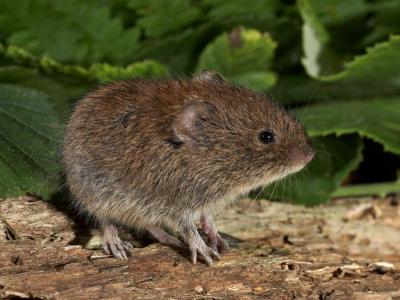 |
Facts
Scientific Name: Myodes glareolus
Weight : 15-40g
Life Span: Up to 18 months
Description :
As the UK's smallest vole, the adult Bank Vole has a reddy-brown coat with a rounded, mouse-like appearance, prominent ears and a long tail. An agile
creature, the Bank Vole can move fast over most terrain and it is also a very capable climber and swimmer.
Distribution :
The Bank Vole is found throughout most of the British Isles, but may not inhabit some of the smaller islands.
Habitat :
Usually found in woodland and thick undergrowth as well as riverbanks and hedgerows, and amongst brambles and bracken..
Diet :
Bank voles feed on buds, leaves, fruit and some insects. They often climb among bushes while foraging for food.
|
|
BLACK RAT |
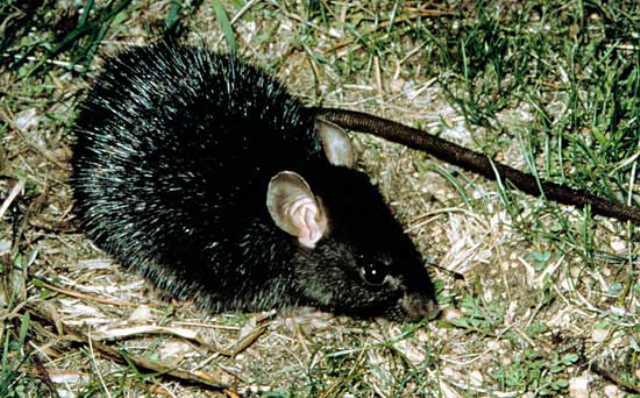 |
Facts
Scientific Name: Rattus rattus
Weight : 150-200g
Life Span: The Black Rat normal lifespan is usually a year in the wild.
Description :
The Black Rat has a pointed nose, large ears and a slender body when compared to the Brown Rat (Rattus Norvegicus).
Distribution :
Fairly rare in the U.K. where it is confined mainly to ports and the coast.
Habitat :
In it's natural habitat the Black Rat is a tree dweller, but Black rats are highly adaptable and can be found in a variety of habitats, typically near human
habituation
Diet:
They are omnivorous, but are more partial to fruit than brown rats are.
|
|
BROWN HARE |
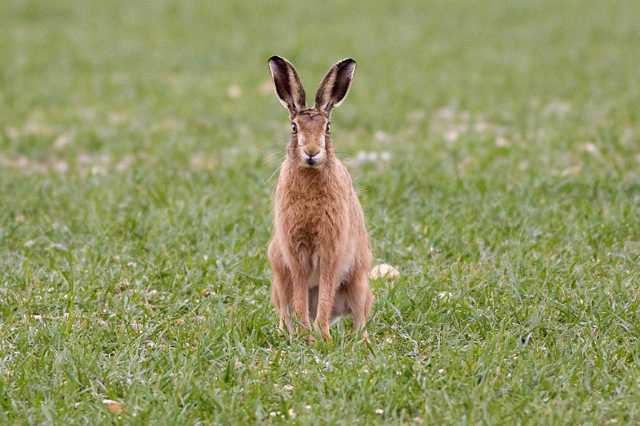 |
Facts
Scientific Name: Lepus europaeus
Weight : 48-70g
Life Span: 3 - 4 years
Description :
Similar to a rabbit but with longer, larger black tipped ears and longer hind legs, the fur is tawny grey/brown in colour with a lighter coloured underbelly
and flanks.
Distribution :
With the exception of the Highlands of Scotland and rarely seen in Ireland, the Brown Hare may be observed throughout mainland British Isles.
Habitat :
Living above ground, the Brown Hare makes its home in long grass, maybe on airfields and open downland. A fairly rare sight more likely to be seen in the
early morning or evening.
Diet:
It eats grasses and herbs during the summer months but changes to feeding on twigs, bark, and the buds of young trees in winter.
|
|
BROWN RAT |
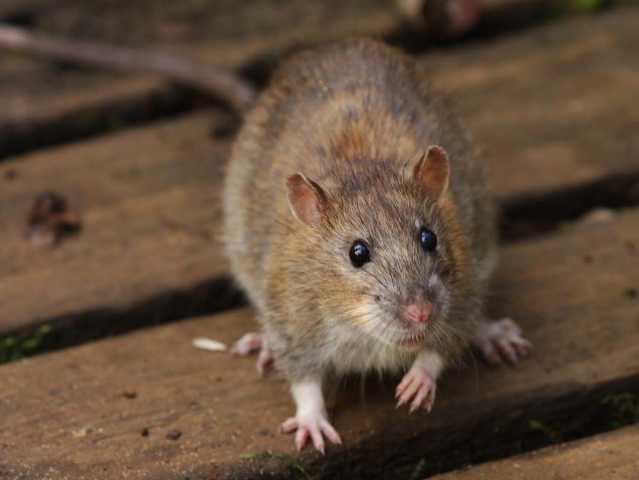 |
Facts
Scientific Name: Rattus norvegicus
Weight : Up to 400g
Life Span: Up to 18 months
Description :
The Brown rat has coarse, grey-brown fur with a thick scaly tail, which is always shorter than its body, and has small finely haired ears.
Distribution :
Brown rats are common throughout the UK including inner city areas.
Habitat :
Found in almost every type of habitat from woodlands, riverbanks and farmland to rubbish tips, sewers and urban areas.
Diet:
Brown rats are omnivorous but prefer starch and protein-rich foods, such as cereals. Their diet includes meat, fish, vegetables, weeds, earthworms,
crustaceans, nuts and fruit. They sometimes cache food to return to later.
|
|
CHINESE WATER DEER |
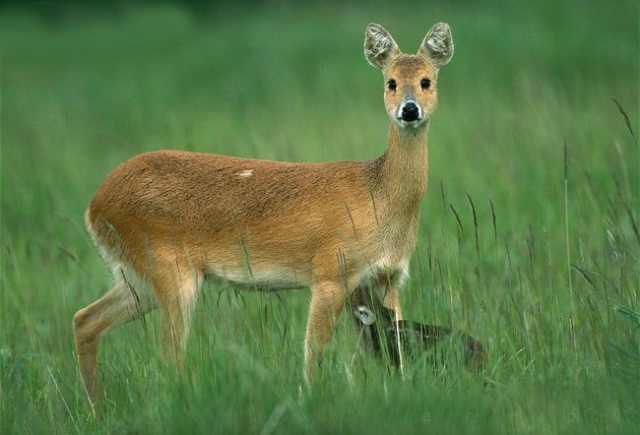 |
Facts
Scientific Name: Hydropotes inermis
Weight :11-18kg
Life Span: Up to 6 years. Up to 40% of fawns die within the first four weeks of life
Description :
A small species intermediate between muntjac and roe deer. No antlers but large protruding tusks in bucks, which are generally only visible in adults. The
tusks are used as weapons during the rut and in defence against predators. Ears large and rounded giving a "teddy bear" like appearance. Coat a russet-brown
in summer pale to grey-brown in the winter. Water deer lack the white caudal patch of roe deer.The Chinese water deer's tusks indicate that it is a very
primitive form of deer. Tusks were developed as weapons by deer before antlers evolved. Chinese water deer were first kept at London Zoo in 1873 but
escaped from Whipsnade Zoo after introduction there in 1929. Originally being centred around their site of escape they slowly spread to surrounding areas
of suitable habitat.
Distribution :
Currently restricted to Bedfordshire, Cambridgeshire and Norfolk with a few scattered sightings elsewhere. Introductions into deer parks around the country,
and subsequent escapes and releases, have facilitated their spread, although wet habitats in the fens of Cambridgeshire and the Norfolk Broads seem to
provide them with the best habitat in which to thrive.
Habitat :
Reed beds, river shores, woodlands and fields. A good diversity of plants in the understorey is important.
Diet:
Selective feeders that take small morsels from nutritious plants, especially herbs but may take woody browse, grasses and sedges if food is limiting.
|
|
COMMON SHREW |
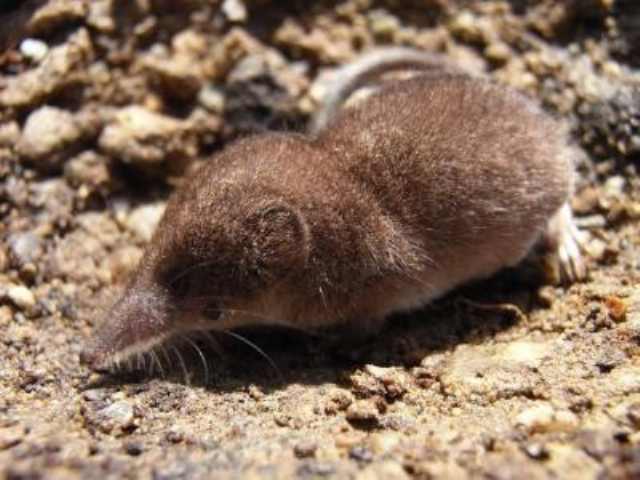 |
Facts
Scientific Name: Sorex araneus
Weight :5-15g
Life Span: Up to 2 years
Description :
Silky brown fur, a grey underside and a long narrow nose are probably the most distinguishing features of the common shrew.
Distribution :
Found throughout much of the British Isles, the common shrew only fails to make an appearance in the Outer Herbides, the Isle of Man and some of the
northern Isles.
Habitat :
Often found in areas of dense vegetation including long grass, hedgerows and riverbanks, but also wooded areas and farmland.
Diet:
Common shrews are insectivorous and carnivorous, feeding on insects, slugs, spiders, worms and carrion. They need to eat 80-90 per cent of their own
body weight in food daily.
|
|
DORMOUSE |
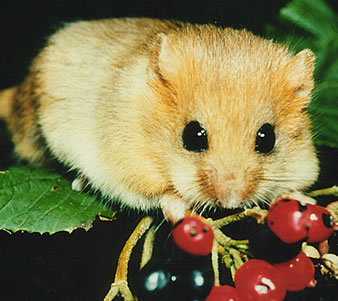 |
Facts
Scientific Name: Muscardinus avellanarius
Weight :15-26g , up to 43g before winter hibernation
Life Span: up to 5 years
Description :
A small orange colured mammal which is declining in Britain. It is nocturnal and spends its entire life in the trees feeding on insects fruits and nuts. There
are thought to be 80,000 dormice left in the UK.
Distribution :
Mostly the southern counties but a few isolated populations in the Lake District.
Habitat :
Ancient Hedgegrows and woodland.Mostly in Hazel trees.
Diet:
Dormice are omnivorous, typically feeding on fruits, berries, flowers, nuts and insects.
|
|
EDIBLE DORMOUSE |
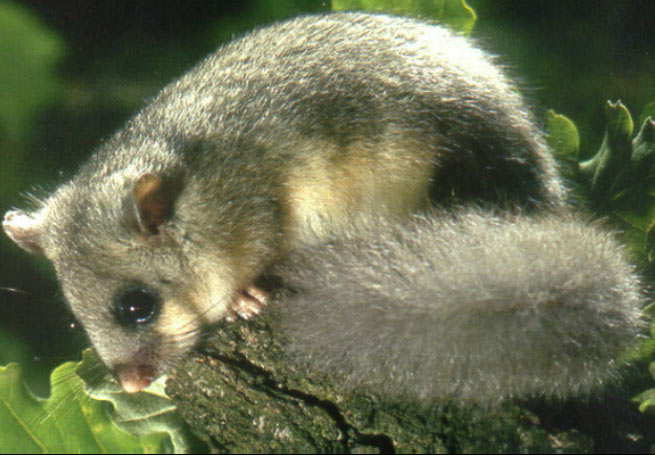 |
Facts
Scientific Name: Glis glis
Weight :Up to 250g Up to 250g
Life Span: Up to 7 years
Description :
Significantly larger than the dormouse, the Edible Dormouse has a uniform grey coat with white underside and large, bushy tail, and is almost as big as a
squirrel.
Distribution :
Found largely in and around the Chilterns, just northwest of London. Not native to the UK Lord Rothschild introduced this dormouse from Europe, to his
estate in Tring, in around 1900.
Habitat :
In the locality in which it is found, woodland provides its main habitat although lofts, barns and outhouses may also offer a home. The dormouse builds both
summer and winter nests - as the Fat dormouse hibernates from October til April.
Diet:
Edible dormice feed on nuts, fruit, buds, bark, insects, carrion and occasionally eggs and nestlings.
|
|
FALLOW DEER |
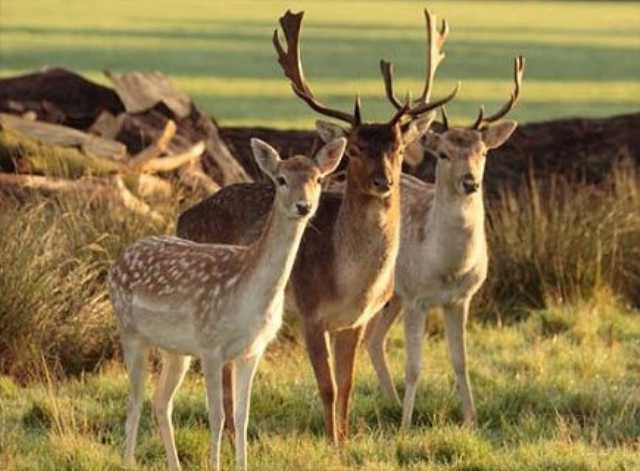 |
Facts
Scientific Name: Dama dama
Weight :The male Fallow Deer weighs between 50 - 95kgs, but the female is about half this weight at 55kgs.
Life Span: Up to 16 years, but 8 - 10 years being the norm.
Description :
Fallow Deer vary greatly in appearance - both 'black' and 'white' herds, together with another variety having larger spots. The spots tend to disappear in
winter as the coat turns grey/brown. However, the Fallow Deer has a very distinctive white rump with black border and tail.
Distribution :
Not as widespread as either the Red or Roe Deer, the Fallow may still be found in the Forest of Dean, New Forest, Epping Forest and Cannock Chase, in
addition to a number of parks.
Habitat :
Dense woodland and parkland.
Diet:
Preferential grazers of grasses although trees and dwarf shrub shoots will be taken during autumn and winter.
|
|
FIELD VOLE |
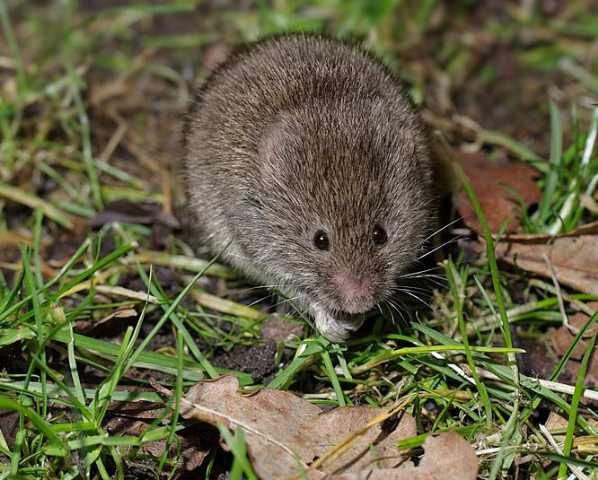 |
Facts
Scientific Name: Microtus agrestis
Weight :14 - 50gram
Life Span: Up to 2 years
Description :
They have grey brown fur, small eyes and ears with a short tail and have pale grey underparts.
Distribution :
Widely distributed throughout the British mainland but are absent from Ireland and some islands.
Habitat :
Grassland, meadows and marshland.
Diet:
It feeds primarily on the stems and leaves of grasses
|
|
FOX |
 |
Facts
Scientific Name: Vulpes vulpes
Weight :They usually weigh 3 to 14 kg with males being slightly larger than females.
Life Span: A fox may survive for up to 2 years in the wild, normally, but a lifespan of 10 years has been known.
Description :
A slender dog like animal with reddish brown upper coat and white/grey underparts, plus a bushy white tipped tail which is approx. 40cm in length.
Distribution :
Found throughout the UK, though rarely found on smaller islands.
Habitat :
A common mammal, the fox inhabits a den, or earth, often hollowed out under a tree root; sometimes the fox will cohabit with badgers.
Diet:
Rodents, birds, insects, carrion and fruit.
|
|
HARVEST MOUSE |
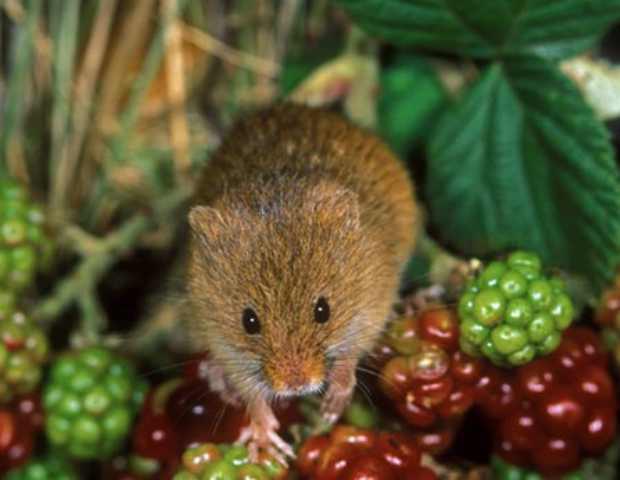 |
Facts
Scientific Name: Micromys minutus
Weight :The Harvest Mouse weighs less than a 2p coin.
Life Span: Approx. 18 months.
Description :
Britain's smallest rodent, the Harvest Mouse yellow-brown furry upper parts and whiter underbelly, small ears and a blunt nose, with a long tail.
Distribution :
In Britain the Harvest Mouse may be found in parts of Wales and from Yorkshire southwards in England.
Habitat :
Originally often found in the area of cornfields, the advent of large reaping machines has meant that Harvest Mice are now generally found in the vicinity
of undisturbed grass, hedgerows, reedbeds and allotments.
Diet:
They feed mainly on seeds, fruits and bulbs, but a tiny proportion of their diet is made up of insects, particularly in the summer, as well as roots, moss and
fungi. Some food is cached underground for the winter.
|
|
HEDGEHOG |
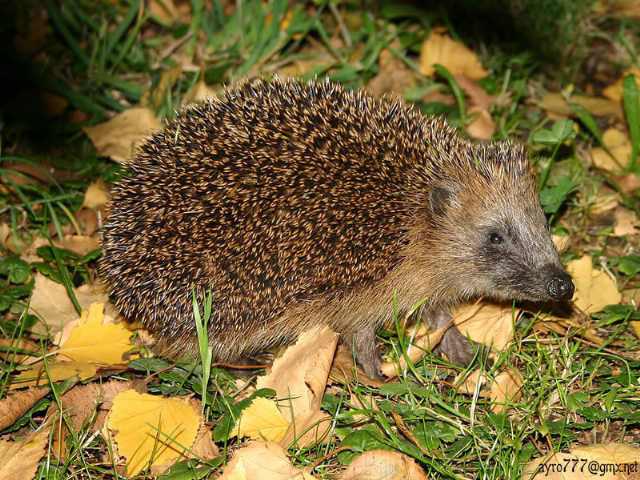 |
Facts
Scientific Name: Erinaceus europaeus
Weight :Up to 2kg
Life Span: The hedgehog may live for up to 5 years.
Description :
Yellow-tipped 2cm spines on it's grey/brown back and sides are perhaps the best known features of the hedgehog, which has relatively long legs and and
short tail, together with small eyes and ears. The hedgehog is generally nocturnal.
Distribution :
This insectivorous animal is well established throughout the British Isles.
Habitat :
Hedgehogs, as the name suggests, may live in the undergrowth of hedges, in gardens, woodland edges and rough pasture. Winter hibernation begins in
October when they may dig a small hole and cover themselves with leaves and moss to survive the winter, emerging once more in April.
Diet:
Hedgehogs feed on insects, snails, frogs and toads, snakes, bird eggs, carrion, mushrooms, grass roots, berries.
|
|
HOUSE MOUSE |
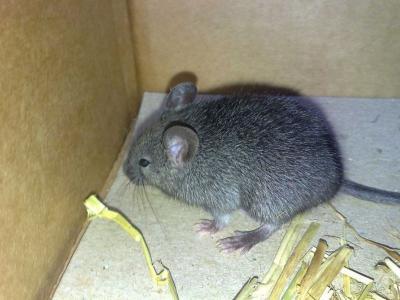 |
Facts
Scientific Name: Mus domesticus
Weight :12 - 22 grams
Life Span: Average 9 -12 months but can be up to 2 years
Description :
Grey-brown fur, slightly paler underneath the body. Long, sparsely furred, scaly tail. Prominent ears and large eyes (but eyes not as large as those of the
Wood Mouse). Usually has a typical 'mousy' smell.
Distribution :
Mainly associated with humans, and widespread throughout Britain and Ireland. A few populations are found in fields well away from human habitation.
Habitat :
Buildings of all kinds where there is food to be found. Also, occasionally, open fields.
Diet:
House mice primarily feed on plant matter, but they will also accept meat and dairy products.
|
|
MINK |
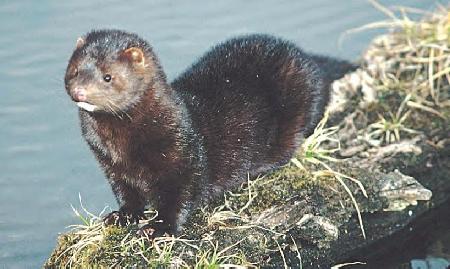 |
Facts
Scientific Name: Mustela vison
Weight :600 g - 1200 g
Life Span: Average 8 years
Description :
A chocolate brown stoat like animal that is related to stoats and weasels. often mistaken with otters due to their aquatic life but are much smaller.
Distribution :
Faily well established in England and a fair few in Wales and Scotland.
Habitat :
Rivers, lakes any fairly large watercourse.
Diet:
Mink prey on fish and other aquatic life, small mammals (rabbits especially), and birds, particularly water fowl.
|
|
MOLE |
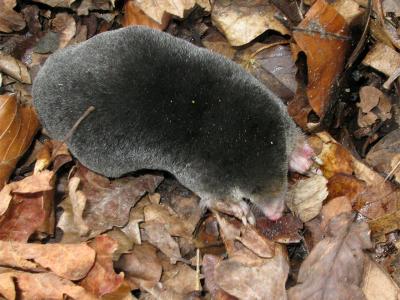 |
Facts
Scientific Name: Talpa europaea
Weight :Around 80grams, with the female being lighter than the male.
Life Span: 2 - 5 years
Description :
Moles have cylindrical bodies, black fur and tiny eyes, which are difficult to see for the thick fur surrounding them, and while they have ears, they are not
visible. They have a small snout and tail, both covered in sensory hairs. The hairs around the face and nose are used to detect worm and insect movement.
When moving through their tunnels the tail is held erect to brush the tunnels walls, allowing the fine sensory hairs on it to detect vibrations passing through
the ground.
Moles do not hibernate and are active throughout the year.
Distribution :
Widespread throughout mainland Britain but absent in Ireland.
Habitat :
Underground
Diet:
A mole's diet primarily consists of earthworms and other small invertebrates found in the soil.
|
|
MOUNTAIN HARE |
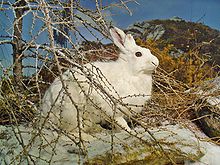 |
Facts
Scientific Name: Lepus timidus
Weight :2.5 -4kg
Life Span: Usually up to 10 years
Description :
Sometimes known as the Blue hare because of Blue-grey summer coat, but in winter it turns white except for black ear tips and brown splodge on the nose.
Distribution :
Found in the Scottish Highlands, locally in southern Scotland, the Pennines, Snowdonia and it is the only Hare native to ireland. It favours upland moors
althugh it descends to lower altitudes in really harsh winters.
Habitat :
Upland moors and mountains.
Diet:
In areas where snow may blanket the ground for many months, the hares may graze on twigs and bark. In areas where snowfall is rare, such as Ireland,
grass may form the bulk of the diet. Given a choice, Mountain Hares in Scotland and Ireland seem to prefer feeding on grasses.
|
|
MUNTJAC DEER |
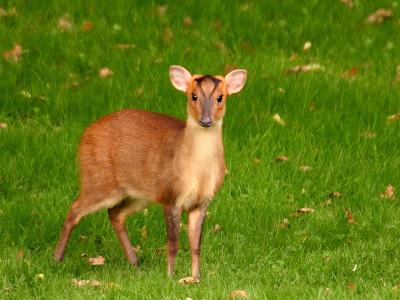 |
Facts
Scientific Name: Muntiacus reevesi
Weight :12-15kg
Life Span: Up to 20 years
Description :
A small dark red/brown deer with white underside to the head and throat and a white rump.
Distribution :
Originating in China, muntjacs were introduced to Woburn park in Bedfordshire in the early 1900s. Escapees during the past century have successfully
reproduced in the wild and created significant populations across many parts of the south of England.
Habitat :
Muntjacs prefer sheldered areas that can provide good protection from the elements and potential predators. Usually found in woodlands or amongst dense
vegetation amd long grass. Also found in scrub and over-grown gardens in urban areas.
Diet:
Selective feeders that take small morsels from nutritious plants. Diet varies according to region and availability but may include herbs, brambles, ivy,
heather, bilberry and coppice shoots.
|
|
OTTER |
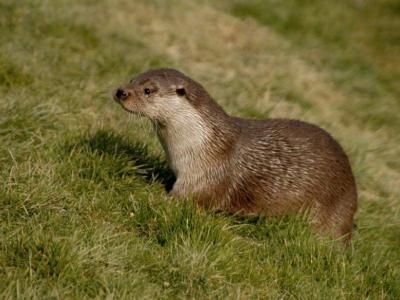 |
Facts
Scientific Name: Lutra lutra
Weight :5-12kg
Life Span: Up to 10 years
Description :
Otters have the typical Mustelid body shape of a long, slim body and skull with powerful jaws. They have webbed feet and a powerful rudder like tail, which
they use to propel them through water. They have two types of fur - thich waterproof guard hairs and a dense, fine underfur that provides insulation. The
colouring is chestnut brown and lighter underbelly.
Distribution :
Widely found throughout the U.K. but difficult to spot due to it's secretive nature.
Habitat :
Rivers, streams, lakes, marshes and coastal areas.
Diet:
All kinds of fish and crabs.
|
|
PINE MARTEN |
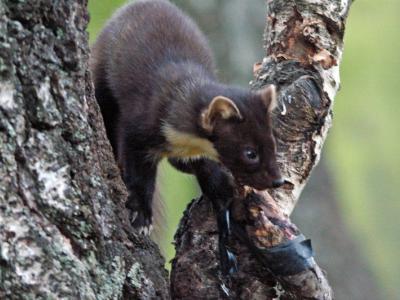 |
Facts
Scientific Name: Martes martes
Weight :Approx. the size of a domestic cat - up to 1.7kg.
Life Span: Up to 10 years.
Description :
A long bushy tail with long rich grey/brown fur on its upper parts, the throat or bib of the pine marten is creamy-yellow.
Distribution :
Most British Pine Martens are found in the north of Scotland, and although there have been sightings further south in North Yorkshire and Northumberland,
they are rarely seen.
Habitat :
Woodland, scrubby cliff and sometimes mountainous areas are the home of the elusive Pine Marten. It will make its home in rock crevices, birds nests,
holes in trees and old squirrel dreys.
Diet:
Although pine martens are carnivores, their diet is omnivorous, and they eat a variety of foods, including carrion, rabbits, voles and other small mammals,
birds and their eggs, reptiles, amphibians, fish, crustaceans, beetles, fruits, berries, hazelnuts and fungi.
|
|
POLECAT |
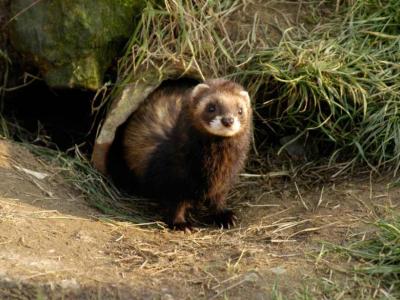 |
Facts
Scientific Name: Mustela putorius
Weight :600-900gms
Life Span : Possibly up to 5 years with a few older exceptions.
Description :
With white markings on the tips of their ears and the end of their snout, the Polecat has a long body with short legs and two-toned fur which is creamy-yellow
at the base and black at the tip, giving a dark brown appearance.
Distribution :
Strong populations in Wales as well as the central and southwest regions of England
Habitat :
A variety of habitats from woodland and grassland areas to coastal dunes and farmland.
Diet:
They feed on small animals and eggs and are quite destructive to poultry and small game.
|
|
PYGMY SHREW |
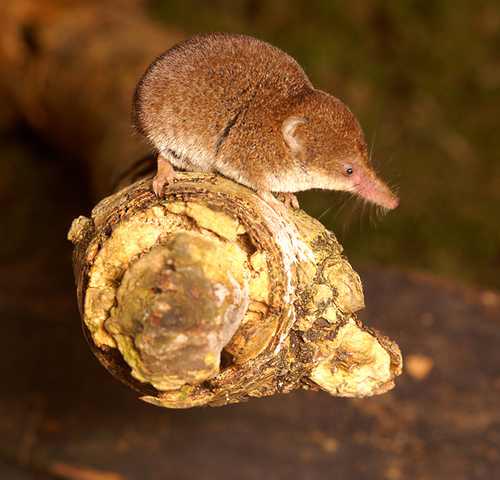 |
Facts
Scientific Name: Sorex minutus
Weight :Between 3 - 6 grams, less than a ten pence piece
Life Span : About 13 months
Description :
The Pygmy Shrew is Britain's smallest mammal. It has brown fur and has a pointed, narrow nose and a bulbous head. They are solitary creatures and are
intolerant of other shrews except during the breeding season. They are active both during the day and night.
Distribution :
Throughout the U.K.
Habitat :
Moors, forest and farmland.
Diet:
They feed on insects, spiders, slugs, snails and carrion.
|
|
RABBIT |
 |
Facts
Scientific Name: Oryctolagus cuniculus
Weight : Up to 2kg
Life Span : Up to 10 years.
Description :
Short brown/greyish fur tinged orange at the nape, with a short black tipped white tail and long ears.
Distribution :
Commonly seen throughout the British Isles.
Habitat :
Unlikely to be found in coniferous forest areas, Rabbits may be found on almost any other habitat such as heathland, grassland, sand dunes and woodland.
Diet:
Rabbits are herbivores who feed by grazing on grass, forbs, and leafy weeds. In consequence, their diet contains large amounts of cellulose, which is hard
to digest. Rabbits solve this problem by passing two distinct types of feces: hard droppings and soft black viscous pellets, the latter of which are
immediately eaten. Rabbits reingest their own droppings (rather than chewing the cud as do cows and many other herbivores) to digest their food further
and extract sufficient nutrients.
|
|
RED DEER |
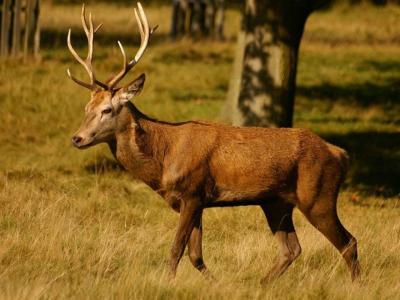 |
Facts
Scientific Name: Cervus elephus
Weight : Up to 225kg
Life Span : 16 - 18 years. Heavy infant mortality at and shortly after birth and during first winter in some Scottish hill populations.
Description :
The largest land animal in the UK, the Red Deer stands over 1.2m to the shoulder. The male deer has antlers that can span over 1m that are used primarily to
display status, rather than as a form of defence or attack. Each winter the antlers are shed. During winter the Red Deer has a brownish/grey coat, changing
to reddish/brown in Summer. They have a beige tail and creamy patch on the rump.
Distribution :
Parks throughout the British Isles may host Red Deer, but they are found in the wild in the New Forest, Highlands of Scotland, West Country and the Lake
District.
Habitat :
Within its range in England and southern Scotland occurs in woodlands and forests but can adapt to open moor and hill on Scottish hills and south-west
England.
Diet:
Grazers of grasses, and dwarf shrubs e.g. heather and bilberry. Woody browse, e.g. tree shoots, is taken when other food is limiting e.g. during winter.
|
|
RED SQUIRRE |
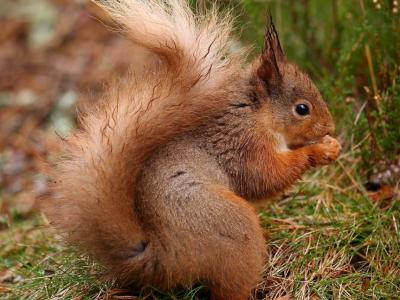 |
Facts
Scientific Name: Sciurus vulgaris leucourus
Weight : 250 - 350 grams
Life Span : up to 7 years
Description :
A small mammal, the red squirrel has a deep reddish brown coat, sometimes tinged grey on the underbelly and tail; the tail is approx. 20cm long.
Distribution :
More commonly found in Scotland than in other areas of the British Isles, although Wales, parts of N Ireland, Isle of Wight and Brownsea island are also
inhabited by this popular mammal.
Habitat :
The red squirrel makes its nest or 'drey' in coniferous woodland where there are approximately one pair of red squirrels per acre.
Diet:
The red squirrel eats mostly the seeds of trees, neatly stripping conifer cones to get at the seeds within. Fungi, nuts (especially hazelnuts but also beech and
chestnuts), berries and young shoots are also eaten.
|
|
ROE DEER |
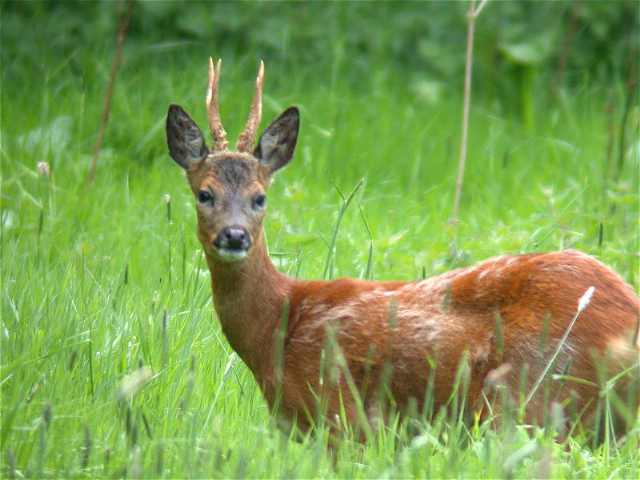 |
Facts
Scientific Name: Capreolus capreolus
Weight : 15 - 30kg
Life Span : Max: 16 years. Bucks rarely exceed 5 years, does 6 to 7 years. Heavy mortality at and shortly after birth and during first winter
Description :
The Roe is the smallest native British deer and its coat varies from grey/brown to black in winter, and reddish/brown to sandy in summer. Their antlers are
much less ornate than those of the larger Red Deer. There is an insignificant tail and a whitish patch on the rump. Their facial appearance suggests a
'moustache'.
Distribution :
Roe deer may be found throughout the British Isles, but they are more commonly found in East Anglia, Scotland, southern counties of England and the Lake
District.
Habitat :
Roe Deer tend to inhabit open woodland which provides the cover they seek to pass generally unnoticed.
Diet:
Browsers that activley select different food types including herbs, brambles, ivy, heather, bilberry & coniferous tree shoots.
|
|
SHORT TAILED VOLE |
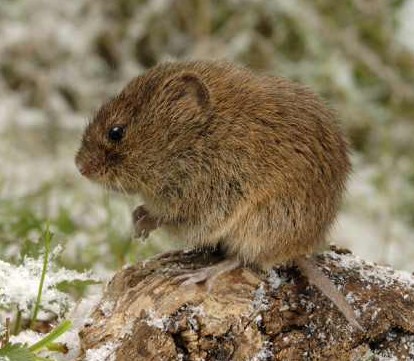 |
Facts
Scientific Name: Microtus agrestis
Weight : Average 20- 40g
Life Span : Up to 2 years
Description :
Grey-brown above, cream-grey below - more even than Bank Vole. Tail less than 40% of body length, tail also much shorter than that of Bank Vole. Ears
are almost completely covered by fur, whereas those of bank vole are more prominent. The eyes are relatively smaller than those of Bank Vole.
Distribution :
Common in mainland Britain, but absent from Scottish islands. They are also absent from Ireland.
Habitat :
Rough ungrazed grassland, hedgerows, wherever grass growth is available.
Diet:
Short tailed vole will eat tree bark, grasses, roots and the occasional insect.
|
|
SIKA DEER |
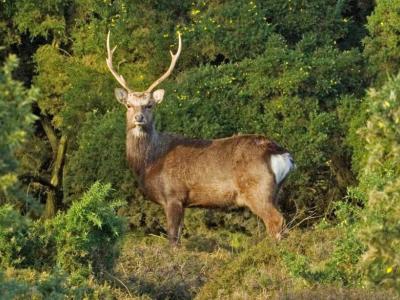 |
Facts
Scientific Name: Cervus nippon
Weight : 50-60kg
Life Span : Up to 15 years
Description :
Intermediate in size between roe and red deer. Similar pelage to fallow deer, but darker. Reddish brown to yellow-brown, dark dorsal stripe surrounded by
white spots in the summer. Dark grey to black, spots faint or absent during the winter. Tail shorter and with less distinct stripe than fallow. Very distinct
white gland on hind leg.
The Sika deer in Great Britain were first introduced into deer parks 1860, usually imported from their native Japan and Taiwan. Over the past 150 years
many have escaped and bred successfully in wild.
Distribution :
The majority of sika deer in the Uk are found in Scotland and Ireland, however, there are also small numbers in the south of England, such as the New
Forest, as well the Lake District and parts of Lancashire.
Habitat :
Dense woodland areas esp coniferous woodlands and heaths on acid soils.
Diet:
Grazers of grasses and dwarf shrubs, especially heather. Coniferous tree shoots and tree bark may occasionally be taken in small quantities.
|
|
STOAT |
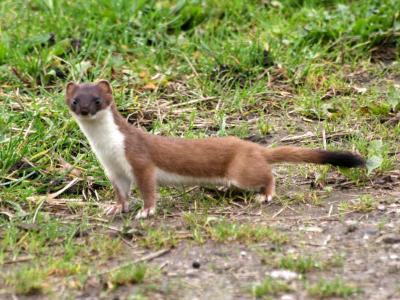 |
Facts
Scientific Name: Mustela erminea
Weight : Up to 450g
Life Span : Up to 10 years
Description :
Creamy white underparts, which are more apparent when it sits upright, with a brown head, back and flanks - the end of it's tail is black tipped. In winter the
Stoat's coat may turn completely white, apart from the tail tip.
Distribution :
Found throughout much of the UK, but only in small numbers, though surveying Stoat populations is extremely difficult.
Habitat :
Found in a variety of rural and semi-rural areas.
Diet:
Mainly rabbits and other small mammals. Also birds, eggs, earthworms, large insects and carrion.
|
|
WATER SHREW |
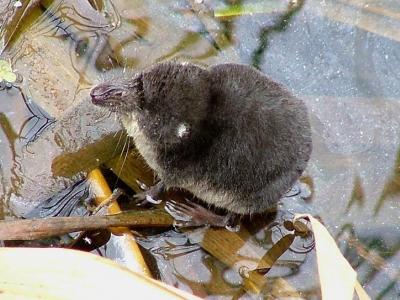 |
Facts
Scientific Name: Neomys fodiens
Weight : Between 10 and 22 gms
Life Span : Up to 18 months
Description :
A black coat with silvery-white underparts, white ear tips and eyebrows, with a medium length tail, are the distinguishing features of this little mammal.
Distribution :
The Water Shrew may be found throughout the British Isles, with the exception of Northern Ireland.
Habitat :
Although as the name suggests you may find the Water Shrew in and around water, they also inhabit beaches and dry downland.
Diet:
They feed on a variety of aquatic and terrestrial invertebrates, including small fish and amphibians.
|
|
WATER VOLE |
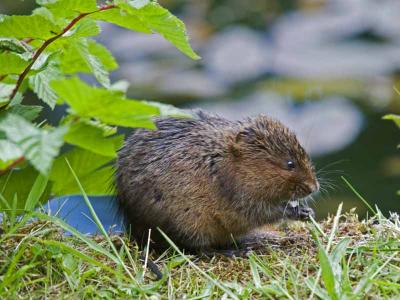 |
Facts
Scientific Name: Arvicola terrestris
Weight : 140 - 350 grams
Life Span : 12 - 18 months
Description :
Dark chocolate brown fur, with a chubby face and blunt nose and a shorter tail than a rat.
Distribution :
The Water Vole is found throughout most of England and Wales, though less common in Scotland with little evidence in the north, and absent from Northern
Ireland.
Habitat :
Burrows in the waterside bank with the entrance above or below the waterline of slow running rivers and sometimes dykes and ditches.
Diet:
Water voles are herbivores, feeding on a huge variety of waterside vegetation and consume 80 percent of their body weight each day
|
|
WEASEL |
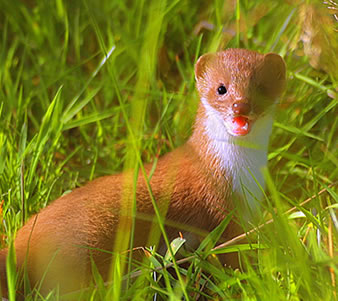 |
Facts
Scientific Name: Mustela nivalis
Weight : Up to 130g Male, and 70g Female.
Life Span : Average 18 months
Description :
With a long slender body and short tail the Weasel has gingery/russet brown fur and is the smallest British flesh eating mammal.
Distribution :
With the exception of Northern Ireland, the Weasel is found throughout most of the British Isles.
Habitat :
Found in a variety of habitats ranging from farmland and grassland to sand dunes and woodland.
Diet:
Weasels mostly eat rodents, such as voles and mice, supplemented by birds or eggs in season. They must eat every 24 hours to avoid starvation. Weasels are
active both day and night, alternating periods of activity with a few hours of rest.
|
|
WILD BOAR |
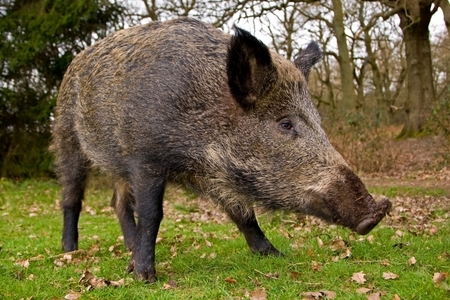 |
Facts
Scientific Name: Sus scrofa
Weight : Between 50 - 200kg.
Life Span : They can live for 15 - 20 years.
Description :
The Wild Boar is an ancestor of our domestic pigs. They have long bodies, short legs and a large head on a short neck. The coat consists of short bristly hair,
which is dark or brindled with the snout being prominent and the ears large and hairy. Wild Boars are extremely vocal and will grunt and chirrup to each
other and will emit a loud squeal when threatened or alarmed.
Distribution :
Feral groups are now located in several locations throughout the U.K.
Habitat :
Mainly broad leaved woodland.
Diet:
Roots, fruits, nuts, fungi, insects, amphibians, reptiles, small mammals, birds, carrion.
|
|
WILDCAT |
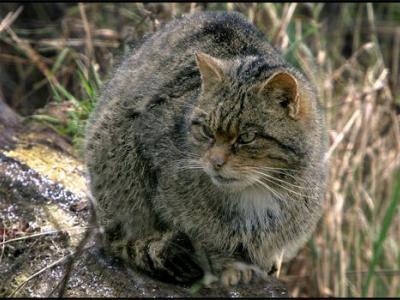 |
Facts
Scientific Name: Felis sylvestris
Weight : Adult males average 5kg; females 4kg.
Life Span : Up to 12 years though most die much younger.
Description :
Britain's only native cat. They look very similar to domestic tabby cats but are much larger, have a stockier build and a thick bushy tail, which has 3–5 broad
black bands of fur and a rounded black tip. The colour of their coat varies from greyish to yellowish-brown. They have thick white whiskers.
Distribution :
Wildcats are confined to Scotland, north of Glasgow and Edinburgh, but are absent from the Scottish Islands. Live mainly in upland areas.
Habitat :
Edges of forests were they meet mountains, moorlands and rough pastures. They dislike high mountain areas, exposed coasts and fertile lowlands with
intensive farming.
Diet:
The wild cat is an obligate carnivore, like all felines and consumes almost every part of any kill it makes; the coat providing roughage, the bones calcium
and the meat everything else, in fact they rarely need to drink because meat has such a high water content. The Wildcat often carries parasitic worms in its
gut and will eat long blades of grass to help clear out its system and probably also to obtain certain necessary acids not present in meat.
The wild cat is a hunter of small mammals, birds, rabbits, hares and game and other creatures of a similar size. They sometimes scavenge and cache prey to
return to it later.
|
|
WOOD MOUSE |
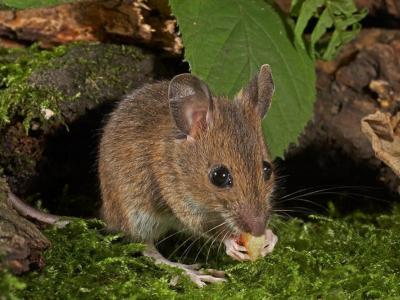 |
Facts
Scientific Name: Apodemus sylvaticus
Weight : Up to 27g
Life Span : Approx. 18 months.
Description :
Large ears and protruding eyes, together with dark sandy brown upper parts and white under belly, with a long tail.
Distribution :
The Wood Mouse is found throughout the British Isles.
Habitat :
As the name implies the Wood Mouse is likely to be found in woods, but is also adept at thriving on moorlands, in gardens and buildings - in fact, almost
anywhere! They make their homes in tunnels under ground which they also use for storing food. These tunnels may be used by several generations of Wood
mice.
Diet:
Wood mice feed on seeds, buds, fruits, insects, worms, centipedes, snails and fungi.
|
|
YELLOW NECKED MOUSE |
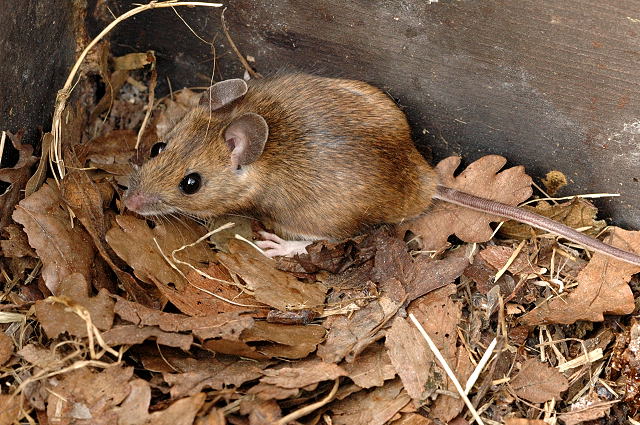 |
Facts
Scientific Name: Apodemus flavicollis
Weight : 25 - 45g
Life Span : Up to 1 year
Description :
They are very similar in appearance to the Wood Mouse, who they are related to. They have sandy brown fur and white undersides and can be distinguished
from the Wood Mouse by a yellow spot, which extends to form a collar. They are also slightly larger than the Wood Mouse. They are nocturnal and are
excellent climbers, enabling it to forage for food amongst high branches.
Distribution :
They are concentrated around the Welsh border, the South-East Counties and the Western Cotswolds.
Habitat :
They prefer deciduous woods but are also found in hedgerows, arable land and gardens.
Diet:
Yellow-necked mice have a very similar diet to wood mice, feeding on seeds, buds, fruits, insects, worms, centipedes, snails and fungi.
|
|
GREY SQUIRREL |
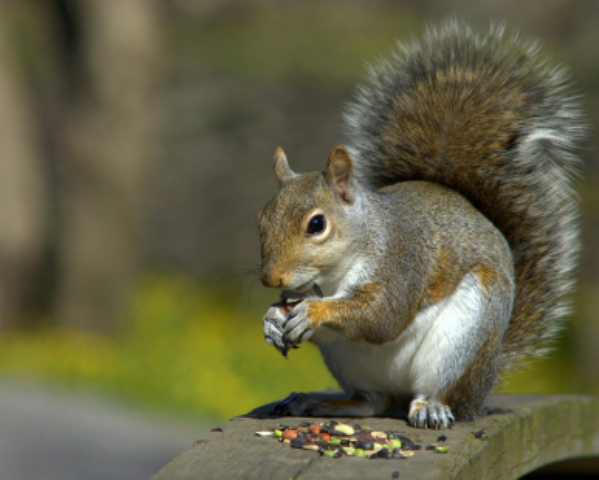 |
Facts
Scientific Name: Sciurus carolinensis
Weight : 400-600g.
Life Span : Up to 9 years.
Description :
Grey squirrels are distinguished from red squirrels by their grey fur, smaller ear tufts and their larger, more robust build. Grey squirrels sit with their large
bushy tail arched over the back.
Distribution :
They are widespread throughout England and Wales, south of Cumbria, and are common in local pockets in Scotland.
Habitat :
Common in deciduous and mixed woodland, they are also found in hedgerows, trees, parks and gardens.
Diet:
Grey squirrels feed on acorns, tree shoots, flowers, nuts, fruits, roots and cereals. They bury surplus food 2-5cm below the soil or in tree hollows.
|